
7 New Google Statistics That Change Everything for Dental Marketing
There have been several studies this year that unveiled shocking statistics about how people are searching with Google. But unless you’re a marketing expert, it can be hard to decipher how this information affects your practice, or what you can do in your dental marketing to take advantage of these new insights.
We’ve rounded up the 7 most important Google statistics, and explain how they affect dental marketing and new patient attraction, so you can make the right decisions and start booking more new patients via the world’s most-search engine.
1. 92% of all search queries are long-tailed keywords. (Backlinko)
Chances are, you chose your search-engine optimization keywords a while ago, and never updated them again. However, this statistic acknowledges a major pivot in how patients are searching with Google, by using more words when they search then they ever had. “Long-tailed keywords” include phrases like “implant dentist in New York City” or “pediatric dentist in Portland Oregon,” and most patients are searching this way!
How can you use this to your advantage? Choose new SEO keywords, including long-tailed keywords, and start optimizing your website for them. You can use the Top 60 SEO Keywords for Dentists to get started.
2. Four times as many people are likely to click on a paid search ad on Google (63%) than on any other search engine. (Clutch)
Paid ads can be a divisive conversation in dental marketing, but this statistic gives dentists confidence that Google is their most reliable investment for paid ads. While you want to diversify your visibility, it is important to know which platform will continuously produce new patients for your practice. Long story short: don’t quit on Google ads, because the patients most likely to convert are using those ads to find a new dentist.
3. 89% of URLs and 37% of URLs in positions 1-20 rank differently on mobile and desktop. (SEMRush)
Imagine investing in your SEO strategy, hiring a marketing company, and finally ranking on the top spot on Google….only to learn that when a patient searches on mobile, you are not in the top spot. In fact, you’re on page two, where most patients aren’t looking!
This statistic informs us that just because you rank high on the desktop version of Google, doesn’t mean patients are finding you! More and more patients are using their phones to search for a dentist, so you need to make sure you know your rankings on desktop and mobile.
4. The average click-through rate for first place on desktop is higher than that of mobile, at 31.5% and 24% respectively. (Advanced Web Ranking)
Thanks to the previous statistic on this list, we know that mobile rankings are different from desktop rankings. But this insight into click-through rates informs us that both rankings are equally important, because when you are ranking in the top spot on the desktop version of Google, you are more likely to convert patients. Make sure your SEO is working hard to make you visible on both desktop and mobile!
5. Compressing images and text increases page rank on Google SERPs. (Google)
Using personalized images and text on your dental website is critical to convert more new patients. But if your images are not “compressed” (in other words, packaged smaller so they can load quickly on your site) your website ranking will suffer. You need site speed, high rankings, and personalized content on your website in order to effectively book new patients with your website, don’t sacrifice one to achieve the others!
6. In 2021, 56% of web traffic took place on mobile phones. (Broadband Search)
This is one of the most staggering statistics of this entire list! With more than half of patients viewing your website on their phones, is your website optimized for mobile? Are your images and information all overlapping, or does your website still look nice, and encourage patients to call your practice or move forward? Taking steps to optimize your website for mobile can help you convert more patients through your website...and get your phones ringing!
7. 14% of Google searches are a question. (Backlinko)
Back in the day, marketers assumed most searches were phrased as a question. With a statistic as low as 14%, we now need to consider: what words are patients using to search? And what types of questions are patients asking that make up that 14%? The answers might surprise you, but you don’t have to go far to find them. You can adapt your SEO strategy to target the most-searched phrases with this 2021 SEO for Dentists Guide.
Staying up-to-date with search trends can help you market smarter, more successfully, and get more new patients just by adapting to the way they search for a new dentist! If you want a dental marketing company that will keep your marketing strategy up to speed, then click below to book your Marketing Assessment Call.
